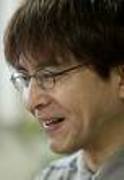Difference between revisions of "Yoshiyuki Sadamoto"
| Line 4: | Line 4: | ||
Sadamoto is the creator of the [[Neon Genesis Evangelion (manga)|Neon Genesis Evangelion-based manga series]], his first full manga work, which is an alternate continuity to that of the original series. He is also the author of the shorter 60-page manga ''Route 20'' (1991), as well as the author of 2 short novels, ''Dirty Work'' and ''System of Romance''. When he was 19, his manga work was published in the Akita Shoten weekly ''Shonen Champion''. He decided to become a manga artist, he said, "[r]ight about the time I was in elementary school and middle school, Mazinger Z by Go Nagai, and Leiji Matsumoto's Battlefield manga series were just coming out. About that time I thought it might be nice to become a manga artist."<ref>[http://eva.onegeek.org/pipermail/oldeva/1999-January/024322.html Interview] Animerica Vol 6, Issue 8.</ref> | Sadamoto is the creator of the [[Neon Genesis Evangelion (manga)|Neon Genesis Evangelion-based manga series]], his first full manga work, which is an alternate continuity to that of the original series. He is also the author of the shorter 60-page manga ''Route 20'' (1991), as well as the author of 2 short novels, ''Dirty Work'' and ''System of Romance''. When he was 19, his manga work was published in the Akita Shoten weekly ''Shonen Champion''. He decided to become a manga artist, he said, "[r]ight about the time I was in elementary school and middle school, Mazinger Z by Go Nagai, and Leiji Matsumoto's Battlefield manga series were just coming out. About that time I thought it might be nice to become a manga artist."<ref>[http://eva.onegeek.org/pipermail/oldeva/1999-January/024322.html Interview] Animerica Vol 6, Issue 8.</ref> | ||
| − | + | In 2003, Viz published a collection of his works, titled ''Der Mond'' ("The Moon"). Other artbooks like ''Die Sterne'' ("The Stars") and ''Groundwork of FLCL'' showcase his talent. He also did the artwork for the cover of Eric Clapton's album ''Pilgrim''. | |
In ''Der Mond'', he describes the brainstorming sessions between him and Hideaki Anno during the Evangelion project.<ref>[http://eva.onegeek.org/pipermail/evangelion/2006-November/003855.html Interview in Der Mond] translated by Bochan Bird</ref> Hos contributions included suggesting that Anno make the lead character a boy instead of a girl, pushing the name "Evangelion" over "Alcion," using the idea that "the dead mother is inside the robot, which is operated by mental/psychical bonding with the child" after learning about the A10 nerve from a program on NHK, and also making the series for TV instead of an OVA. | In ''Der Mond'', he describes the brainstorming sessions between him and Hideaki Anno during the Evangelion project.<ref>[http://eva.onegeek.org/pipermail/evangelion/2006-November/003855.html Interview in Der Mond] translated by Bochan Bird</ref> Hos contributions included suggesting that Anno make the lead character a boy instead of a girl, pushing the name "Evangelion" over "Alcion," using the idea that "the dead mother is inside the robot, which is operated by mental/psychical bonding with the child" after learning about the A10 nerve from a program on NHK, and also making the series for TV instead of an OVA. | ||
Revision as of 08:38, 3 February 2014
Yoshiyuki Sadamoto (貞本 義行) is best known as the character designer for Neon Genesis Evangelion. He was also, along with Hideaki Anno, Takami Akai and Shinji Higuchi, one of the founding members of the Gainax anime studio. Before it was officially founded as Gainax (it was originally called Daicon Film), Sadamoto worked as an animator on the the Daicon III and IV opening animations. His first work as a character designer with Gainax was in Royal Space Force: The Wings of Honneamise in 1987. He worked as animator on Gainax projects Gunbuster (1988), Nadia: The Secret of Blue Water (1990), and Diebuster (2004). Sadamoto designed characters for many projects with Gainax and others, including Nadia, FLCL (2000), .hack//Sign (2002), Diebuster, The Girl Who Leapt Through Time (2005), Summer Wars (2009), Wolf Children (2012), and the Rebuild of Evangelion movies. In 2007 he was key animator for episode 27 of Tengen Toppa Gurren Lagann, and was both animation director and key animator for Evangelion 1.0 You Are (Not) Alone.
Sadamoto is the creator of the Neon Genesis Evangelion-based manga series, his first full manga work, which is an alternate continuity to that of the original series. He is also the author of the shorter 60-page manga Route 20 (1991), as well as the author of 2 short novels, Dirty Work and System of Romance. When he was 19, his manga work was published in the Akita Shoten weekly Shonen Champion. He decided to become a manga artist, he said, "[r]ight about the time I was in elementary school and middle school, Mazinger Z by Go Nagai, and Leiji Matsumoto's Battlefield manga series were just coming out. About that time I thought it might be nice to become a manga artist."[1]
In 2003, Viz published a collection of his works, titled Der Mond ("The Moon"). Other artbooks like Die Sterne ("The Stars") and Groundwork of FLCL showcase his talent. He also did the artwork for the cover of Eric Clapton's album Pilgrim.
In Der Mond, he describes the brainstorming sessions between him and Hideaki Anno during the Evangelion project.[2] Hos contributions included suggesting that Anno make the lead character a boy instead of a girl, pushing the name "Evangelion" over "Alcion," using the idea that "the dead mother is inside the robot, which is operated by mental/psychical bonding with the child" after learning about the A10 nerve from a program on NHK, and also making the series for TV instead of an OVA.
In 2008, he produced a two-part manga called Archaic Smile with his mangaka wife, Mako Takaha, that appeared in Monthly Shonen Ace.[3]
Notes
References
- ↑ Interview Animerica Vol 6, Issue 8.
- ↑ Interview in Der Mond translated by Bochan Bird
- ↑ Anime News Network 5/8/08
- ↑ Resources:Character_Name_Origins

